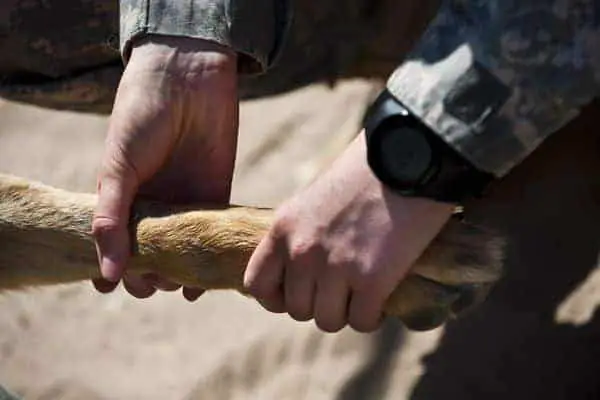Every year during summer, a significant number of dogs die of heatstroke. Every passing year the number is consistently increasing due to an excessive rise in temperatures and increased heat waves.
Unlike humans, dogs only have a few sweat glands on the bottom of their paws that help dissipate minimal heat from their bodies. Dogs resort to panting instead of sweating when the average body temperature elevates to a higher level. If the soaring heat in the body becomes unbearable for most of the four-legged friends, they suffer from hyperthermia (as opposed to hypothermia).
What Is Heat Stroke?
When the body temperature rises sharply, both humans and animals suffer from heatstroke, which is a form of hyperthermia. If the body temperature of a dog elevates to more than 102.9 degrees Fahrenheit (39.4 degrees Celsius), the animal suffers from hyperthermia. If there is a constant exposure to heat, and the temperature surpasses 41 Degree C without any prior ailments in stray dogs, they either suffer from acute heat-related injuries or die.
Symptoms Of Heatstroke In Dogs
The prime method that dogs resort to when it comes to eliminating high heat from the body is panting. With the consistent rise in humidity and temperature in summer, especially in the daytime, due to inadequate shelter, water, and food, shedding heat from the body becomes notably tricky for dogs. When a dog is unable to cool its body for an extended period, the brain damages and multiple organs fail to work. During such a scenario, you will find a dog suffering from the following common symptoms:
- Consistent Salivation
- Heavy Panting
- Diarrhea
- Incontinence
- Breathlessness
- Urinating Blood
- Seizures
- Unconsciousness
- Memory Loss
Also, you will understand that dogs are suffering from heatstroke if you notice the following signs:
- Fast Heart Rate
- Darkened Tongue
- Glassy Eyes

Table of Contents
What Are The Factors Other Than Rising Temperatures That Affect Dogs?
Apart from the increase in temperatures and environmental heat and humidity, the body temperature of dogs also elevates due to the following reasons:
- Age
- Health Conditions
- Activities
- Fur Thickness
- Weight
- Head Shape
Why Dogs Suffer From Heatstroke?
Primarily there are two types of heatstroke that dogs suffer from, one is exertional, where the dog overheats from things like running around, and another non-exertional, where the dog overheats due prolonged exposure to heat, such as being left in a car.
It takes at least 3-4 weeks, if not more, for dogs to acclimatize to the excessive rise in humidity and temperature in summer. Dogs suffer from heatstroke due to prolonged exposure to external heat while performing vigorous activities under the sun.
The majority of the dogs die due to non-exertional factors in the summer months. When a dog has minimal ventilation, food or water to cool itself, it is more likely to experience hyperthermia and can die of heatstroke. Dogs that are left in cars on hot summer days are one of the primary cases of this, which is why you see auto makers such as Tesla setting up systems in their vehicles to ensure that if you have to leave your dog in the car it is kept cool using the AC system without having to keep the car running.
Which Breeds Of Dogs Are More Susceptible To Heatstroke?
Dogs that belong to the brachycephalic breeds are more likely to develop symptoms of hyperthermia than other breeds of dogs. Pugs, bulldogs, boxers, and all those dogs that have flat faces are more vulnerable to heatstroke. Even if there is only a moderate rise in the temperature and humidity, the body temperatures of these dogs significantly elevate.
Due to significantly protruding snout of some dogs, the panting capability decreases immensely and it often leads to heatstroke. It is through panting a dog can maintain its body temperature. So when the body temperature increases beyond the normal level, typical signs and symptoms of heatstroke can be observed in dogs.
Dogs suffering from fever caused by an infection called pyrexia are at greater risks and more likely to become victims of heatstroke.
How Should You Take Care Of A Dog When It Is Affected By Heatstroke?
If you observe the signs and symptoms that are mentioned above in any stray dog, then immediately take it in a shade or a cool place and make it drink water to cool its body.
Keep in mind that if immediate measures are not taken for a dog that suffers from a high body temperature or hyperthermia, may die without a few hours. It is therefore important that you call the local authorities right away if you find a dog suffering from heatstroke.
Even if you notice any of the potential symptoms in your pet dog, then you should make sure to take it into shade and give it plenty of water, if that doesn’t make a significant difference quickly then take it to a vet as quickly as possible. While taking your pet to a vet’s clinic in your car, make sure that someone is there with you to help reduce its body temperature by applying a wet towel on the chest and head.
You can also take your pet dog at once to the washroom and run a cool shower over the back of its head and neck for a few minutes.
Make sure while taking the dog to a clinic in your car that the windows are open or the car air-condition system is switched on to lower the elevated body temperature of the dog.
What Could Be The Possible Outcome For Heatstroke?
One thing that is for certain is that if a dog that is suffering from heatstroke doesn’t get treatment as soon as possible then it will die. Obviously, the level of heatstroke that the dog is suffering from will greatly affect how long the dog is likely to survive and the negative heath conditions should it survive.
When recommending a course of action, vets will take into consideration the dog’s medical history if known, as they can tailor the response based on what is known about the dog.
Veterinarians also consider a dog’s physical health conditions prior to the heatstroke. In case the body temperature of a dog doesn’t surpass the expected level, then receiving proper treatment and medications can help a dog recuperate effectively.
When experiencing heatstroke the dog’s body will start shutting down internal organs to try and reduce the amount of heat that their body is creating. If the dog survives heatstroke then the shutting down of the organs can have lasting implications for the health of the dog. One system that may be damaged due to heatstroke is the dog’s thermoregulators system. The thermoregulatory system, as the name suggests, looks to maintain the dog’s temperature through different means. If this system if affected then it may mean that the dog will find it more difficult to regulate its body temperature going forwards, increasing its likelihood of suffering hyperthermia again.
Read on the following to gain comprehensive information about the common complications that the majority of the dogs suffer from once affected by heatstroke:
Disseminate Intravascular Coagulation
The risk for bleeding increases in a dog when it suffers from Disseminate Intravascular Coagulation. Blood coagulation is what leads to scabs forming to close up wounds that may have been experienced and stopping the blood from escaping the body. Disseminate Intravascular Coagulation is a pathologic process that leads to the coagulation of blood throughout the body of a dog and exhausts the body of coagulation matters and blood platelets. When a dog is affected by heatstroke, the intravascular system gets majorly disrupted. The risk for the death of a dog increases if DIC gets triggered due to heatstroke.
Multiple Organ Dysfunction Syndrome
Due to alteration in the functioning of two or more organs of a dog, this particular symptom becomes noticeable. The organs function in an improper way owing to hyperthermia or heat stroke. If both Systematic Inflammatory Response Syndrome and Multiple Organ Dysfunction Syndrome happen at the same time, then the survival chances of a heatstroke affected dog decreases significantly.
Rhabdomyolysis
Due to the random breakdown of fibers of the injured muscles, a dog suffers from Rhabdomyolysis. Rhabdomyolysis is where the skeletal muscles break down. Once Myoglobin gets released into the bloodstream and blocks the kidney structure, muscle necrosis follows it. Both are responsible for causing severe kidney failure in a dog affected by heatstroke.
What Are The Medical Treatments For Heatstroke?
As we’ve already mentioned, responding quickly when you identify that your dog may be suffering from heatstroke is of the utmost importance to try and save their life and minimize the damage to their body. This includes trying to cool your dog down using damp towels, giving them water, getting them into shade and getting them to the vet as soon as possible.
Some of the options that may be taken when you bring your dog into the vets are:
Cooling Method
A veterinary would always suggest you make your dog drink water and pour cool water over it to help to bring down their body temperature if they are overheating. Putting them into a lukewarm bath can be a convenient way to do this, making sure to keep their head out of the water. While this seems obvious depending on the level of hyperthermia the dog may not be in a position to keep their own head above the water. The initial goal of a veterinarian is to bring down the temperature of the dog by applying a towel soaked in lukewarm water on its chest and behind the neck and head. However, you should take care that the vet or its assistants do not use cold water baths or ice to lower the temperature.
Excessive cold water can create a sudden change in the temperature of the body of the dog and may cause peripheral vasoconstriction. So, the ideal way to bring down the heat is to slowly apply a water-soaked towel on its body that doesn’t cause additional stress.
Fluid Treatment
Carrying out this particular treatment aids in replacing the lost fluid and essential minerals from the body of a dog due to overheating. This is carried out through the injection of fluids using an intravenous catheter to try and help the cardiac system function properly. The vet will look to ensure that the amount of fluid and minerals provided are not excessive as this will not help the situation.
Besides checking the body temperature of your furry friend, a veterinarian will also monitor blood pressure and heart rate throughout.
Intensive Nursing Care
To ensure your dog recovers quickly, you may need to keep it at an intensive care unit in a veterinary hospital. Nurses will take care of it and monitor every parameter as per the guidance of the vet. The nurses will leave no stone unturned to look after your dog. Even if a dog is unable to move and pass urine, healthcare providers at the hospital will make use of a urinary catheter to help it stay dry and clean.
Being a responsible dog lover, you will want to ensure you’re taking proper care of your pet dog, especially in summer months, when there is a higher risk for heatstroke or hyperthermia. You should take safety measures and keep your dog in the shade and provide sufficient access to food and water. You are responsible for looking after the well-being of your furry friend. So makes sure that when you are not at home, someone is there to take care and feed it timely. While accidents do happen, the vast majority of cases of heatstroke in dogs is caused when pet owners do not take proper care of their dogs.







